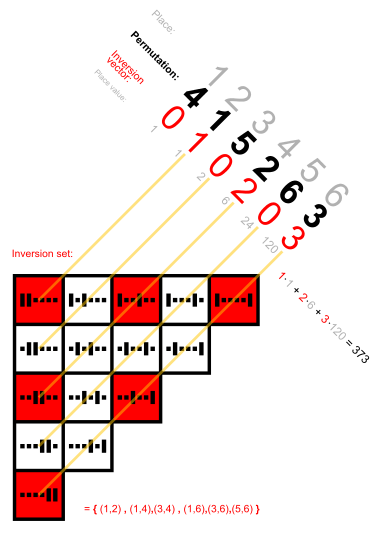Inversion (discrete mathematics)

.svg.png)
(0,15, 14,1, 13,2, 3,12,
11,4, 5,10, 6,9, 8,7)
showing the pattern of the
Thue–Morse sequence
In computer science and discrete mathematics, an inversion is a pair of places of a sequence where the elements on these places are out of their natural order.
Definitions
Formally, let be a sequence of n distinct numbers. If and , then the pair is called an inversion of .[1][2]
The inversion number of a sequence is one common measure of its sortedness.[3][2] Formally, the inversion number is defined to be the number of inversions, that is,
- .[3]
Equivalently, it is the Kendall tau distance from the identity permutation. Other measures of (pre-)sortedness include the minimum number of elements that can be deleted from the sequence to yield a fully sorted sequence, the number and lengths of sorted "runs" within the sequence, the Spearman footrule (sum of distances of each element from its sorted position), and the smallest number of exchanges needed to sort the sequence.[4] Standard comparison sorting algorithms can be adapted to compute the inversion number in time O(n log n).
The inversion vector V(i) of the sequence is defined for i = 2, ..., n as . In other words, each element is the number of elements preceding the element in the original sequence that are greater than it. Note that the inversion vector of a sequence has one less element than the sequence, because of course the number of preceding elements that are greater than the first is always zero. Each permutation of a sequence has a unique inversion vector and it is possible to construct any given permutation of a (fully sorted) sequence from that sequence and the permutation's inversion vector.[5]
Weak order of permutations
The set of permutations on n items can be given the structure of a partial order, called the weak order of permutations, which forms a lattice.
To define this order, consider the items being permuted to be the integers from 1 to n, and let Inv(u) denote the set of inversions of a permutation u for the natural ordering on these items. That is, Inv(u) is the set of ordered pairs (i, j) such that 1 ≤ i < j ≤ n and u(i) > u(j). Then, in the weak order, we define u ≤ v whenever Inv(u) ⊆ Inv(v).
The edges of the Hasse diagram of the weak order are given by permutations u and v such that u < v and such that v is obtained from u by interchanging two consecutive values of u. These edges form a Cayley graph for the group of permutations that is isomorphic to the skeleton of a permutohedron.
The identity permutation is the minimum element of the weak order, and the permutation formed by reversing the identity is the maximum element.
See also
| Wikiversity has learning materials about Inversion (discrete mathematics) |
| Wikimedia Commons has media related to Inversion (discrete mathematics). |
- Factorial number system (a factorial number is a reflected inversion vector)
- Transpositions, simple transpositions, inversions and sorting
- Damerau–Levenshtein distance
- Parity of a permutation
Sequences in the OEIS:
- Index entries for sequences related to factorial numbers
- Reflected inversion vectors: A007623 and A108731
- Sum of inversion vectors, cardinality of inversion sets: A034968
- Inversion sets of finite permutations interpreted as binary numbers: A211362 (related permutation: A211363)
- Finite permutations that have only 0s and 1s in their inversion vectors: A059590 (their inversion sets: A211364)
- Numbers of permutations of n elements with k inversions; Mahonian numbers: A008302 (their row maxima; Kendall-Mann numbers: A000140)
- Number of connected labeled graphs with n edges and n nodes: A057500
- Arrays of permutations with similar inversion sets and inversion vectors: A211365, A211366, A211367, A211368, A211369, A100630, A211370, A051683
References
- ↑ Cormen et al. 2001, pp. 39.
- 1 2 Vitter & Flajolet 1990, pp. 459.
- 1 2 Barth & Mutzel 2004, pp. 183.
- ↑ Mahmoud 2000, pp. 284.
- ↑ Pemmaraju & Skiena 2003, pp. 69.
Source bibliography
- Barth, Wilhelm; Mutzel, Petra (2004). "Simple and Efficient Bilayer Cross Counting". Journal of Graph Algorithms and Applications. 8 (2): 179–194. doi:10.7155/jgaa.00088.
- Cormen, Thomas H.; Leiserson, Charles E.; Rivest, Ronald L.; Stein, Clifford (2001). Introduction to Algorithms (2nd ed.). MIT Press and McGraw-Hill. ISBN 0-262-53196-8.
- Mahmoud, Hosam Mahmoud (2000). "Sorting Nonrandom Data". Sorting: a distribution theory. Wiley-Interscience series in discrete mathematics and optimization. 54. Wiley-IEEE. ISBN 978-0-471-32710-3.
- Pemmaraju, Sriram V.; Skiena, Steven S. (2003). "Permutations and combinations". Computational discrete mathematics: combinatorics and graph theory with Mathematica. Cambridge University Press. ISBN 978-0-521-80686-2.
- Vitter, J.S.; Flajolet, Ph. (1990). "Average-Case Analysis of Algorithms and Data Structures". In van Leeuwen, Jan. Algorithms and Complexity. 1 (2nd ed.). Elsevier. ISBN 978-0-444-88071-0.
Further reading
- Margolius, Barbara H. (2001). "Permutations with Inversions". Journal of Integer Sequences. 4.
Presortedness measures
- Mannila, Heikki (1984). "Measures of presortedness and optimal sorting algorithms". Lecture Notes in Computer Science. 172: 324–336. doi:10.1007/3-540-13345-3_29.
- Estivill-Castro, Vladimir; Wood, Derick (1989). "A new measure of presortedness". Information and Computation. 83 (1): 111–119. doi:10.1016/0890-5401(89)90050-3.
- Skiena, Steven S. (1988). "Encroaching lists as a measure of presortedness". BIT. 28 (4): 755–784. doi:10.1007/bf01954897.